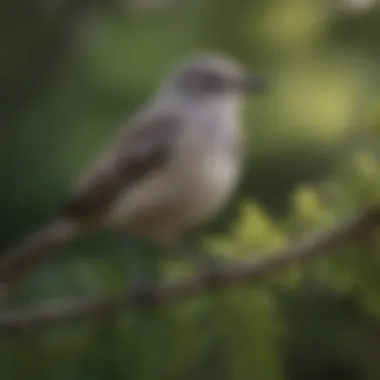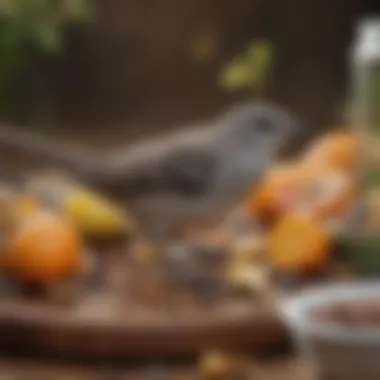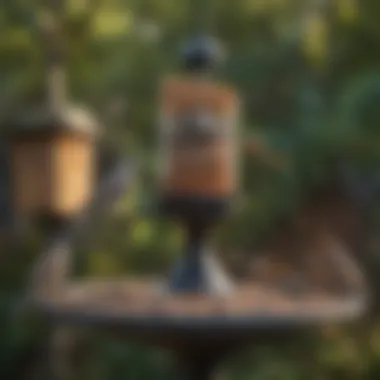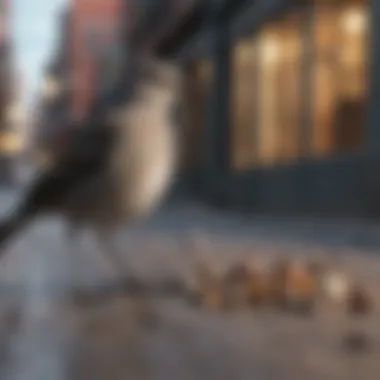Understanding the Dietary Needs of Mockingbirds


Intro
Mockingbirds, with their vibrant personality and melodic songs, have charmed humans for centuries. But what lies beneath their delightful exterior? Delving into the dietary needs of these clever birds reveals much more than just their charming presence in parks and gardens. Understanding the nutritional requirements of mockingbirds can enlighten bird enthusiasts, wildlife biologists, and even families on how to support these creatures effectively.
This guide aims to offer an insightful exploration into the various aspects that shape the diet of mockingbirds. From their favorite food sources to the particular behaviors they display while foraging, we will present a comprehensive analysis of what these birds require to thrive. The right nutrients are just as critical for mockingbirds as they are for humans; the difference lies in the food types and habitats.
With a growing interest in conservation and wildlife support, recognizing how to create an environment that facilitates their feeding habits can foster healthier populations. The interactions between food availability and mockingbird health and breeding are vital aspects that will be discussed. By the end, readers will not only grasp the essentials of mockingbird nutrition but also how to integrate that knowledge into their own backyard habitats, ultimately allowing more of these enchanting birds to flourish.
Prelims to Mockingbirds and Their Diet
Mockingbirds, with their striking melodies and vibrant presence, are a delight to behold in gardens and parks. Understanding their dietary needs is key to fostering an environment where they can thrive. This section outlines the critical aspects of mockingbird diets and highlights the importance of recognizing their omnivorous nature, seasonal food variations, and how providing them with appropriate nutritional sources can lead to healthier, more vibrant populations.
Understanding Mockingbird Behavior
Mockingbirds are often seen flitting about in search of food, and their curious nature plays a vital role in their foraging habits. Watching them hunt for insects or picking through berries can be a spectacle. They are known for their adaptability, often adjusting their foraging strategies based on the availability of food in their surroundings.
These birds are not solitary; their social behavior influences their feeding habits. Mockingbirds will often feed in groups, relying on their keen eyesight to spot food items. This communal behavior allows them to discover new food sources and monitor potential threats from predators.
Additionally, their vocal abilities serve not only to attract mates but also to defend their territory, indirectly affecting their access to food. When they establish their territory in an area rich in food sources, it leads to better nutritional intake and, consequently, improved health. They can mimic the calls of other birds too, which can be a clever strategy to distract competitors or intruders.
Omnivorous Eating Habits
As omnivores, mockingbirds have a diverse palate, which is key to their survival. They chow down on anything from insects to fruits, and this flexible dietary approach helps them adapt to changes in their environment. Here are some notable points about their eating habits:
- Insects and Other Arthropods: Mockingbirds thrive on a variety of insects, such as caterpillars, beetles, and grasshoppers. These high-protein food sources are crucial during breeding season when nutrient needs peak.
- Fruits and Berries: They are especially fond of fruits like blueberries, blackberries, and strawberries. The juicy sweetness not only provides them with energy but also keeps them hydrated.
- Seeds and Nuts: In addition to fruits and insects, mockingbirds also enjoy a selection of seeds and nuts, particularly in the colder months when other food sources may be scarce. This preference varies seasonally, reflecting the availability of those food types.
It’s insightful to note that the diverse diet of mockingbirds allows them to efficiently utilize their environment. Not only do they contribute to pest control by preying on insects, but they also aid in seed dispersal which supports plant life. Mockingbirds don’t just fluff their feathers and enjoy their food; they’re integral to the ecosystems they inhabit.
Understanding the dietary habits of mockingbirds not only enriches one’s knowledge of this fascinating species but also influences conservation efforts aimed at sustaining their populations.
In the upcoming sections, we’ll dive deeper into the specific food types preferred by mockingbirds, exploring their impact on health and well-being, and how enthusiasts can make their backyards more inviting for these melodious birds.
Food Types Preferred by Mockingbirds
Understanding the preferred food types of mockingbirds is crucial in recognizing how their diet influences their overall health and behaviors. Being omnivorous, they don't just eat anything but have distinct preferences that can vary seasonally, dependent on availability. This section breaks down the elaborate list of food sources, focusing on insects, fruits, berries, seeds, and nuts. Each type plays a significant role in providing the necessary nutrients mockingbirds need to thrive.
Insects and Their Role in Diet
Insects are often undersung heroes in the diets of mockingbirds. These feathered critters feast on a variety of insects such as caterpillars, beetles, and ants. During the breeding season, the protein-rich content of insects particularly supports the growth of chicks. It's interesting to note that mockingbirds can consume large quantities of insects in a single day, making them significant contributors to local ecosystems by helping control the insect population.
Moreover, the foraging method of mockingbirds, characterized by their keen eyesight and agile movements, allows them to locate these insects effectively. They hop around in shrubs and on the ground, flipping leaves to reveal hidden prey, a behavior that speaks to their adaptability.
Fruits and Berries: A Vital Component
Mockingbirds have a love affair with fruits and berries, an integral part of their diets. They are particularly drawn to the sweet, succulent offerings of nature, which provide not just energy but also vitamins and antioxidants that maintain their health. The consumption of ripe berries also supports their hydration needs, particularly in dry spells.
Seasonal Availability


Seasonal availability of fruits poses a fascinating element in the diet of mockingbirds. Depending on the time of year, different berries come to fruition. For instance, blackberries and raspberries start appearing in late spring, while mulberries are often ripe during summer.
The key characteristic of seasonal availability is its direct influence on food intake for mockingbirds. With the seasons changing, mockingbirds must be savvy foragers, knowing when and where to find their favorite foods. Notably, certain fruits may only have a brief window of availability, prompting these birds to travel greater distances in search of sustenance.
Advantages of accommodating to seasonal changes allows them to diversify their diets, but it might also challenge them when familiar favorites aren't around. The importance of this adaptability can't be understated in their quest for a balanced diet.
Preferred Varieties
When it comes to preferred varieties of fruits, mockingbirds show a marked preference for sweet fruits like mulberries, dogwoods, and serviceberries. This section highlights how certain berries not only provide nourishment but also contribute to the enjoyment of the bird itself; after all, who isn't drawn to sweetness?
The distinguishing feature of these preferred varieties often lies in their availability during peak breeding seasons, providing energy and sustenance for both adult birds and their fledglings. Incorporating these fruits into a habitat designed for mockingbirds can encourage their presence and support healthy populations.
However, as rainfall patterns and temperatures fluctuate, the availability of these berries can change dramatically, making it crucial for enthusiasts to understand what to expect and how to plan for these variations in their own gardens.
Seeds and Nuts: Nutritional Value
Seeds and nuts round out the mockingbird’s diet and are essential fuel for these avian wanderers. Rich in calories, seeds provide essential fatty acids and are often a significant food source during colder months when other foods might be less available. Mockingbirds will actively seek sunflower seeds, peanuts, and various tree nuts when hunger calls.
Optimal Feeding Practices for Mockingbirds
Feeding mockingbirds isn’t just about tossing out a few crumbs and calling it a day. It entails a thoughtful approach that considers their diverse diet, habitat characteristics, and unique feeding routines. By establishing optimal feeding practices, bird enthusiasts can create a nurturing environment that encourages these lively creatures to thrive in both urban and natural settings. The right practices can also help ensure mockingbirds receive the nutrition they need to maintain their health, vigor, and breeding success.
Feeding Stations: Best Practices
Location Considerations
Choosing the right location for feeding stations is crucial. Mockingbirds prefer areas that offer a mix of shelter and open space. This is because they are naturally curious birds and often like to scan the area for potential threats before they feed. A good spot might be near dense bushes or shrubs; this not only provides protection from predators but also a nearby perch where they can feel safe while eating.
Furthermore, the distance from human activity can impact their feeding. Placing feeders away from high-traffic zones encourages birds to visit more frequently. Remember, too much noise or sudden movements can startle these birds, causing them to steer clear of the area.
Other practical considerations include sunlight exposure. Mockingbirds appreciate feeders that are shaded during the hottest parts of the day to avoid overheating. Therefore, locations that provide a mix of light and shade can be particularly appealing.
Type of Feeders
The type of feeder utilized is equally important. Different feeder designs cater to various feeding behaviors and preferences of mockingbirds. For instance, platform feeders are a hit because they provide ample space for multiple birds to feed simultaneously. They allow easy access to a variety of foods, such as fruits, seeds, and insects.
Another popular choice is tube feeders, which can accommodate smaller seeds. It’s essential to ensure these feeders are securely hung or anchored to deter potential thieves—squirrels or larger birds, for instance—that might outcompete mockingbirds for food. But with their ability to cling, it’s always a challenge for fragile food items.
Ultimately, consider mixing feeder types to cater to a broader range of food preferences within the mockingbird population. Each design has its own unique advantages and disadvantages in attracting these lively birds.
Recommended Food Items
Finding the right food items to keep mockingbirds coming back for more is the heart and soul of your feeding routine. Mockingbirds enjoy a wide range of foods, but some options stand out more than others.
Homemade Feed Options
Creating homemade feed options can be highly rewarding. Not only can this be more cost-effective, but it can also ensure that the food is fresh and nutritious. A simple mixture of chopped apples, mashed bananas, and a sprinkle of sunflower seeds can work wonders. Mockingbirds are particularly drawn to fresh fruits, and they can benefit from the variety.


One appealing aspect of homemade feeds is the ability to tailor the ingredients to suit local mockingbird populations. Some might favor more particular fruits like berries or even dried fruits. However, caution must be exercised—not all fruits are suitable. Ensure that grapes or properly-prepared fruits like watermelon are offered; avocados, though delicious to us, can be harmful to birds.
Store-bought Recommendations
On the other hand, store-bought food can be a convenient fallback for those less inclined to mix things up in the kitchen. A good quality seed mix that contains dried fruits, mealworms, and high-quality seeds can meet their nutritional needs efficiently. Brands such as Kaytee and Wagner’s are known for their blends catering to a wide variety of birds, not just mockingbirds.
What’s beneficial about these store-bought options is their convenience and consistency; the food packaging guarantees the right proportion of nutrients that these birds might not always get from foraging. However, it’s crucial to check the ingredients and avoid blends with fillers such as corn or millet, as these might not be very appealing to mockingbirds.
The Impact of Diet on Mockingbird Health
Diet plays a crucial role in the overall health and well-being of mockingbirds. Mockingbirds, being omnivorous, have a wide range of dietary preferences, which allows them to adapt to variable environments. However, providing balanced nutrition is paramount for their survival, especially in urban settings where food sources might be limited. In this section, we will delve into how the right diet influences mockingbird vitality, their breeding success, and their long-term health.
Nutritional Deficiencies and Their Consequences
When mockingbirds don’t get the nutrients they need, it can lead to several health issues. Like other animals, mockingbirds require a range of vitamins, minerals, and proteins to thrive. Here are some common consequences of nutritional deficiency:
- Reduced Immunity: A lack of essential nutrients can weaken a mockingbird's immune system, making them more susceptible to diseases.
- Poor Development: Young mockingbirds, particularly during their fledgling stages, require crucial proteins and fats. Insufficient nutrition during this phase can lead to stunted growth and developmental problems.
- Breeding Impairments: If adult mockingbirds do not have enough nutrients, they may have difficulty reproducing successfully, leading to fewer eggs and a lower survival rate of chicks.
"A balanced diet is not just a luxury; it's a necessity for the mockingbird's survival."
Healthy mockingbirds often showcase vibrant plumage, strong songs, and robust activity levels. Conversely, those lacking proper nutrition may appear duller, quieter, and less willing to engage with their environment. Thus, understanding and addressing the nutritional needs is not just beneficial, it's essential for their very survival.
Breeding and Nesting: Food Requirements
The breeding period is a critical time for mockingbirds, demanding extra attention to their diet. During this time, both male and female mockingbirds have increased nutritional needs.
- Protein-Rich Foods: High-protein items, like insects, are vital during breeding. These proteins support egg production in females and overall vitality in males.
- Fruit and Soft Foods: Berries and soft fruits provide essential sugars and nutrients to help sustain energy levels during nesting activities and territorial defense.
- Calcium Sources: For egg-laying females, calcium is crucial. Sources like crushed eggshells or oyster shells can significantly contribute to the calcium intake that is necessary for strong eggshell formation.
In addition to these food types, the availability of resources can vary by season, impacting how easily mockingbirds acquire the nutrition needed for successful breeding. Keeping habitats enriched with suitable food sources can make a world of difference, ensuring both parents are fit enough to care for their young.
In summary, a mockingbird's diet directly affects its health and reproductive success. As urbanization continues to encroach on natural habitats, understanding these dietary components becomes vital for supporting their populations.
Seasonal Variations in Mockingbird Diet
Understanding how mockingbirds adapt their eating habits with the change of seasons is crucial for both enthusiasts and researchers alike. Seasonal variations in mockingbird diet showcase their adaptability and resilience, reflecting their omnivorous nature. Mockingbirds have an innate ability to exploit a range of food sources, which is especially noticeable as different seasons bring about shifts in food availability. Recognizing these changes can provide valuable insights into their behavior and health, and it can also help in creating optimal feeding strategies for those interested in attracting these birds to their gardens or local parks.
Winter Feeding Strategies
During winter, mockingbirds rely heavily on the food sources that are more abundant and accessible. In this period, it’s essential to supplement their diet as natural food might be limited due to reduced insect activity and the scarcity of fresh fruits. Berries become one of the primary staples for mockingbirds in winter; they are often found in tufts on shrubs and can remain on plants even after snow falls. Common varieties like mallberry and blackberry can attract these birds to residential areas when planted. Here are some practical strategies to feed mockingbirds in winter:
- Plant Native Shrubs: Incorporating shrubs like holly or dogwood can provide natural food.
- Put Out Bird Feeders: Use feeders stocked with high-energy food like suet or seed mixes that include various dried fruits and nuts.
- Provide Fresh Water: Ensuring a source of fresh water is key, especially in regions where the natural sources may freeze.
"Mockingbirds are often seen darting from branch to branch, searching for the berries that winter has left exposed."
Spring and Summer Dietary Changes
As spring rolls in, mockingbirds begin to shift their dietary preferences due to the influx of new food options. This change is not merely a reflection of availability but also of the birds’ nutritional needs as they prepare for breeding. In these seasons, the availability of insects surges, providing much-needed protein for breeding pairs and their new chicks. The following aspects are integral to understanding the changing diet:


- Enhanced Insectivory: Mockingbirds increase their intake of insects, chasing after caterpillars, beetles, and ants, which are plentiful in gardens and parks.
- Fruit Festivities: With warmer weather, fruits like cherries, strawberries, and blueberries become ripe. They are not only a delicious treat for mockingbirds but also offer hydration and essential nutrients.
- Foraging Habits: Mockingbirds typically display more foraging behaviors during this time, often seen hopping around the ground in search of hidden morsels.
Mockingbirds’ ability to exploit seasonal food availability demonstrates their complex relationship with their habitat. By understanding these seasonal dietary changes, one can appreciate not only the adaptability of these fascinating birds but also the importance of maintaining biodiversity in our local environments.
Impact of Urbanization on Food Sources
Urbanization has transformed landscapes, impacting the natural habitats of many species, including mockingbirds. The expansion of cities has brought with it both challenges and opportunities for these adaptable birds. As urban areas grow, mockingbirds encounter new food sources that are often markedly different from what they would find in their native habitats.
Establishing an understanding of how urbanization influences mockingbird diets is crucial for anyone interested in avian ecology or conservation. Half the battle lies in recognizing the specific food sources that become available and how mockingbirds adapt their foraging behavior in response.
Adaptations to Urban Diet
Mockingbirds are remarkable for their ability to adjust their feeding habits to exploit whatever resources are nearby. In urban environments, they may turn to a different variety of foods than those commonly found in rural areas. For instance, fruits from ornamental trees or shrubs planted in yards are often consumed. While the fruits of native plants are ideal, the birds have shown remarkable resilience by taking advantage of what humanity provides.
- Insects: Urban gardens often harbor a robust population of pests, which mockingbirds will eagerly eat.
- Human food scraps: These birds can be seen rummaging through trash bins or even snatching up dropped food in parks.
- Seeds from bird feeders: Many people have taken to leaving feeders stocked with seeds, which conveniently serve as a dietary supplement for these birds.
These adaptations are not merely a survival tactic; they indicate a level of intelligence and flexibility in behavior that makes mockingbirds particularly fascinating. They can exploit diverse food sources, proving that they can thrive even amidst the bustle of urban life.
Conservation Implications
The impact of urbanization extends beyond mere dietary changes; it raises pertinent conservation issues. As mockingbirds adapt to urban diets, there are a few pivotal considerations for wildlife enthusiasts and conservationists alike:
- Nutritional Balance: Not all urban food sources provide the nutrients needed for optimal health. Reliance on low-quality food can lead to nutritional deficiencies.
- Biodiversity Loss: Increased urban development often leads to the loss of natural habitats. This could decrease the variety of food sources that mockingbirds enjoy.
- Education and Awareness: Community initiatives to plant native flora can provide better food sources for mockingbirds and bolster local biodiversity. Encouraging residents to plant berries or native shrubs in their yards can create a buffet for these birds.
"Mockingbirds thrive in urban landscapes, but sustainable practices are essential to ensure they have what they need to survive and flourish."
By creating environments that cater to mockingbirds' dietary needs, cities can play a vital role in fostering wildlife. Involving communities through education can spark interest and promote practices that benefit both mockingbirds and other urban wildlife. This symbiotic relationship illustrates that even amidst urban sprawl, nature can find a way to flourish if given the opportunity.
Closure: Fostering a Healthy Environment for Mockingbirds
Creating an environment conducive to mockingbirds is vital not simply for their survival, but also for the delicate ecosystem they inhabit. Mockingbirds are not just fascinating creatures; they are also significant players in the food chain. By fostering suitable habitats, we can ensure not only their well-being but also that of other species within their local environment.
One primary aspect that often goes overlooked is the idea that every element of a mockingbird's life relies on the readily available food sources. Mockingbirds, with their omnivorous diets, thrive on a variety of foods, including insects, berries, and seeds. However, in urban settings, their foraging options can become limited due to habitat destruction and pollution. Such changes prove detrimental to their health. Therefore, engaging with this topic means advocating for practices that enhance their feeding opportunities.
Caring for these joyful songsters aligns well with broader conservation efforts aimed at preserving biodiversity. When we consider our collective duty to nurture the environment, it becomes even clearer that supporting mockingbirds means we’re fostering a healthier ecosystem altogether.
Creating Mockingbird-Friendly Habitats
Designing a space where mockingbirds can thrive is easier than one might think. It often starts with the right plants. Native flora can offer both food and shelter. Consider incorporating:
- Berry-producing shrubs such as elderberry and serviceberry, which provide nourishment in spring and summer.
- Insect-friendly plants for attracting the bugs that make up a substantial part of their diet.
- Dense bushes or trees where they can find safe nesting locations and retire from predators.
Furthermore, avoiding pesticides can be beneficial. These chemicals can harm essential insects that serve as food sources for mockingbirds. Using organic gardening methods helps to keep their food sources plentiful.
Creating a water source, like a birdbath, also aids in attracting mockingbirds while promoting their health. Regularly refreshing the water can entice these birds to visit frequently, further enriching the habitat you’ve provided.
Encouraging Community Involvement
A significant factor in promoting healthy populations of mockingbirds entirely hinges on community action. Each individual plays a role—educating those around them is crucial. Organizing groups for environmental clean-ups or tree planting certainly makes a difference.
- Workshop Discussions: Hosting discussions or workshops about native plants and wildlife conservation can help spread awareness.
- Social Media Campaigns: Utilizing platforms like Reddit or Facebook can inform the wider public about the importance of mockingbirds and their habitats. Sharing before-and-after photos of native gardens can motivate others to join in the effort.
By working collectively, communities can not only protect mockingbirds but also develop a deeper appreciation for nature and its complexities.
Ultimately, this is not just about conservation—it’s a chance for communities to bond over a shared goal of creating lasting positive change. Through collaboration, awareness, and action, healthy environments for mockingbirds can be nurtured, ensuring their songs continue to resonate through our neighborhoods for generations.







